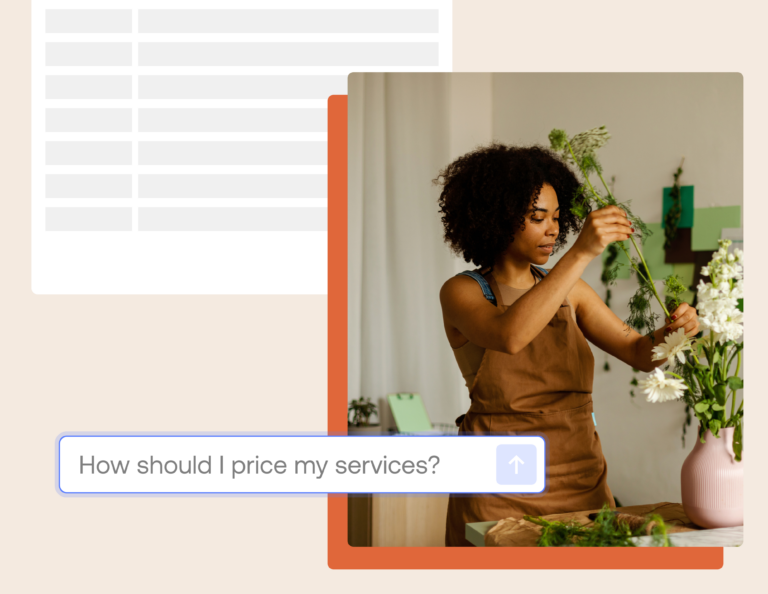How to protect your business from rising costs and market changes

Whether you’ve been following along in the news, browsing your social feed, or even just catching up with friends, talk of tariffs has dominated the conversation in recent months.
But what does it all actually mean for your small business? While it’s easy to assume that tariffs only impact companies that sell physical goods, the reality is far more complex—and potentially costly—for service-based businesses too.
Whether you’re a wedding planner worried about rising event materials costs; or a photographer looking to make pricing adjustments in anticipation of more expensive gear; or a consultant noticing clients cutting back on discretionary spending—the ripple effects of the impending tariff landscape are touching every corner of the economy—and subsequently, your business.
The current tariff situation is particularly challenging because much of it is in flux and changes day by day.
As of this writing, China-specific tariffs are slated to reach a staggering 145% on certain goods. This comes at the same time as an expected 10% universal tariff on imports from most countries, and the elimination of the De Minimis Exemption that previously shielded many small purchases from import duties.
And these changes aren’t just numbers on a form—they’re real costs that are working their way through every supply chain and can ultimately affect your bottom line.
In this post, we’ll cover how the 2025 tariffs can affect entrepreneurs and outline specific steps you can take to protect your business from potential impact.
Understanding the tariff landscape in 2025
What are tariffs, and how do they work?
But…what exactly are tariffs? In short, tariffs are taxes instituted by the US government on goods bought from other countries. For example, if you were to buy a shirt that costs $50 from a company with a 10% tariff, the shirt would then include an additional $5 in tariffs, bringing the total to $55.
These additional costs are paid by the company or individual bringing the product into the US—not by the country being tariffed, which is a common misconception. In turn, the company may respond by passing some or all of the tariff cost onto the consumer, which will increase prices.
As of the publication of this blog, here’s where the tariff policies currently stand:
- A 145% tariff on most Chinese-made goods, with exemptions made for smartphones and computers.
- A 25% tariff on goods from Mexico and Canada
- A 10% tariff on most goods from other countries
- A 25% tariff on foreign vehicles, steel, and aluminum.
The situation is still evolving, so we recommend following a tracker run by a trusted news source or the White House website for updates.
What does this mean for my service-based business?
While it’s true that most service-based businesses will not be affected by tariffs in the same way that goods-based businesses may be, tariffs can still have financial implications.
That’s because our market is largely based on global trade. Even if you’re selling a service like event planning, photography, or consulting, everything you use to perform that service—from equipment to event supplies—is likely to face increased prices. Plus, any vendor or contractor you use may also be feeling the squeeze, which could cause them to pass their own price increases on to you.
Finally, and most importantly, tariffs are likely to strain your clients’ finances across all areas. Economists predict this will reduce consumer confidence and make people likely to spend less—or not spend at all.
For example, say you’re a wedding planner. Your clients are looking to still have a creative and memorable experience, but in light of the recent tariff-related price increases, they now have different parameters—and now it’s time to pivot.
The good news? The only thing that’s constant is change. And independent business owners have always proven to be resilient in the face of these kinds of changes. Today is the day to consider what’s in your control and make small, but impactful preparations to help you be able to weather the storm.
6 ways service-based businesses can prepare for tariffs
1. Audit your business for tariff vulnerabilities
It might sound cliche, but knowledge is power—especially in situations like this one. One of the first things you should do is to take inventory of everything you use or do to run your business.
And then ask yourself, what parts are the most tariff-vulnerable? Common tariff vulnerabilities for service-based businesses include equipment, vendor cost, and any costs of materials to perform your service.
Because you’re a service-based business, it might be difficult to get a hard number on how much tariffs will actually cost your business when they’re fully in effect.
A good rule of thumb is to start having conversations with any suppliers and vendors you work with who might be affected by the tariffs as soon as possible. Even though the situation is still uncertain—getting a gauge on how they’re preparing for tariffs will shield you from getting surprised by increasing prices in the future. They can also help you get estimates on how your total overhead will be with the tariffs fully in effect.
Once you have your estimate in hand, you’ll then be able to get a sense of what it’ll take to reduce your overhead, be able to identify where you can cut back on spending, and create a business that has tariff considerations built in.
2. Invest in critical business needs now
Even though spending more money right now may seem a bit counterintuitive, it’s important to identify any critical business needs that you were planning on investing in the next year or so, and buy them now, before potential tariff costs might raise prices.
So if you have that 10 year old laptop that’s on its last legs, or you’re still driving your 1998 Subaru hatchback with engine problems that you’ve been using to get to different jobs, or you’ve been meaning to upgrade to a new office space—now’s the time.
Tariffs have the potential to raise costs across the board, so even though these all require a significant amount of up front investment, you’ll be potentially saving huge amounts of money in the long run.
3. Utilize digital solutions to reduce overhead
A crucial way small businesses can reduce spending in anticipation of tariffs is to invest in digital solutions that help reduce overall costs and overhead.
Some of the best solutions these days are AI-powered tools. Why? Because with the power of machine learning and large language models, AI might be able to help eliminate tools you no longer need and do more with less time and team members.
Some examples of what AI tools can do include communicating with clients, creating marketing materials, and even creating social media content.
With AI, you and your team can work smarter, not harder; cut costs and boost efficiency across your business while dealing with these looming tariffs.
So, if you’re not already adopting AI to accelerate your productivity and streamline your workflow—now’s the time.
4. Pricing strategy adjustments
One difficult, but often necessary strategy that small businesses often need to deploy in the face of rising costs is adjustments to their overall pricing strategy.
First, and most common, is to adjust the pricing itself. And this doesn’t mean just raising prices indiscriminately across the board. Instead, we’d recommend thoughtful, deliberate price increases—ones that take into consideration what and how much your customer is willing to pay.
This could look like small, incremental increases—to test the waters and gently ease your clients into higher prices. You could even extend their rates for a set period of time, to help lessen the blow even further.
Also, think about adding some budget-friendly options to your lineup. With consumer confidence in freefall—giving clients ways to get parts of what you offer at a lower price point can be the difference between them work with you, or with a competitor.
For instance, if you’re a personal trainer who only does hour-long in-person sessions, you could start offering half-hour workouts or virtual training at lower prices to appeal to more cost-conscious clients.
It might sound counterintuitive, but discounting can also be a key strategic tactic in anticipation of rising costs. Competitive pricing can help bring in more clients now, before the tariffs go fully in effect, so that you’ll be able to shore up cashflow before you might need to deploy higher prices.
We’re already seeing this strategy in the consumer goods space with retailers running “tariff discounts” and encouraging consumers to buy before prices increase.
5. Clear client communications
Regardless of what you decide to implement—it’s critical to be prepared for how you’re going to communicate this to your clients.
Your clients are worried about tariffs too, so start those conversations early to avoid any surprises. Getting ahead of this gives you time to address concerns right from the start.
HoneyBook provides members with legal protection templates, to help communicate to their clients and customers how prices may change during the contract due to tariffs.
These templates help protect both parties by clearly setting expectations and providing a contractual basis for adjusting prices in response to external economic factors, like tariffs. It can be helpful in reducing disputes and ensuring fairness if costs rise unexpectedly.
And finally, when you talk with them, focus on being empathetic and transparent—remember they’re facing the same challenges you are. Approaching them person-to-person rather than as a business will go a long way in maintaining good relationships both now, and well into the future.
6. Stay calm
One of the most important things to keep in mind is the most simple—stay calm.
Even though it’s easier said than done, remember that service-based independent businesses are the best prepared to survive in this current economic climate.
Why? Services aren’t being directly tariffed, which means your business will be buffered from much of the direct cost, and you’ll have more time to pivot and find alternative solutions to serve your customer’s needs and maintain your bottom line.
On top of this, as a small business, your agility gives you an advantage over larger businesses and corporations. And in today’s rapidly changing economy, this speed is essential not just for survival, but for growth.
So if you’re feeling anxious, take a deep breath. Resilience is fundamental to being an independent business owner—you already know how to adapt and overcome challenges, and this one is no different.
You have control over your pricing, expenses, client communications, and operations. Take comfort in this autonomy and use it strategically to prepare for whatever comes next.
The path ahead: How to thrive despite tariff challenges
Navigating tariffs doesn’t need to be overwhelming. While you can’t control what’s happening in the world, you can make strategic and thoughtful moves to minimize the impact on your business.
The businesses that will flourish are those that respond to tariffs not with panic but with a growth mindset to pivot quickly, streamline processes, and ultimately emerge more efficient and resilient.
As the tariff situation continues to evolve, don’t forget that you’re not going through it alone. Staying informed and connected to your business community can be a powerful anchor in a sea of uncertainty. Lean on your industry peers for perspective, advice, and camaraderie.
The landscape may be challenging, but with the right strategies and mindset, your independent business will survive and probably emerge even stronger. After all, adaptability has always been the hallmark of successful small businesses—and in today’s tariff-heavy economy, it’s more valuable than ever.



